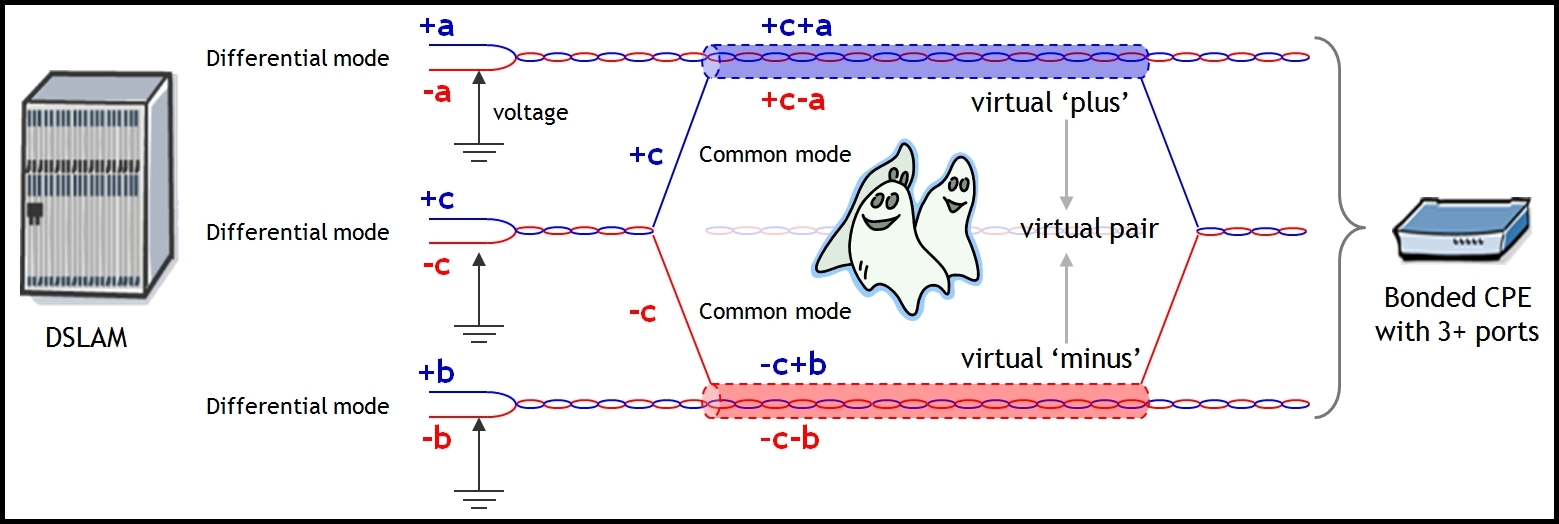Cable Technology Feature Article
July 07, 2010
Phantom circuits boost VDSL2 to 300 Mbps
 By Bob Emmerson, TMC European Editor
By Bob Emmerson, TMC European Editor
Lab trials involving a combination of different technologies have demonstrated that VDSL2 can transport traffic at up to 300 Mbps over distances of around 400 yards/meters (or 100 Mbps at 1 km). This development strengthens the case for using copper ahead of fiber to create the market for high-quality multimedia services.
An earlier article on VDSL2 showed how virtual noise can be introduced in order to minimize the effect of crosstalk and thereby maintain line stability at an optimal bit rate. (See “IPTV (News - Alert) over copper: the issues behind the proposition”). The technique is based on the ability to measure the noise conditions on bundles of twisted pairs and thereby determine the precise amount of virtual noise to be introduced on a per line basis.
Technology has advanced, however, and instead of introducing noise at the relevant part or parts of the frequency spectrum, a noise cancelling technology known as vectoring can now be employed.
Vectoring works the same way as noise-cancellation headphones. It improves the performance of the copper lines and enables data rates of 100 Mbps over relatively short distances (e.g. 400 yards). Field trials with VDSL2 vectoring have started, and the technology is expected to be commercially available in 2011.
phantom circuits
However, vendors are already looking beyond vectoring, e.g. combining it with bonding to deliver even higher bitrates. And Alcatel-Lucent (News - Alert) has added an additional step. The company recently demonstrated a combination of vectoring, bonding, and a well-known analog concept called “Phantom Mode”.
This combination enables the transportation of three channels over two physical pairs, thereby delivering up to 300Mbps. Here’s how it works: you start from a single line. In a noise-free environment, this gets you up to 100Mbps. When a second line is employed data rates do not increase to 2 x 100 Mbps due to crosstalk.
As shown in the following schematic, the second line will typically add an extra 80 Mbps, but the bit rate on the first line will also drop to 80Mbps. Vectoring will eliminate this noise-induced constraint.

300 Mbps is realized by adding a third, virtual twisted pair, using vectoring to eliminate the effect of crosstalk, and then bonding all three lines into one fat pipe.
Creating a third virtual phantom circuit will typically boost throughput by around 50 Mbps. In order to create the third virtual pair, the two physical pairs are used as virtual “plus” and “minus” wires in a virtual pair. (An explanation as to how this is done comes later).
The gain is again impacted, due to the additional crosstalk generated by this third phantom circuit. But when vectoring is applied in order to eliminate crosstalk we get 3 x 100 Mbps. Bonding then allows the three circuits to perform as one fat pipe.
A typical cable bundle or binder will comprise around 50 twisted pairs (although in some countries, binders can contain up to 300 pairs). Therefore working out the resulting interference signal from various adjacent and near-adjacent pairs in real time involves the development of advanced software algorithms that are run on powerful processors.
reviving an old technology
The technology that enables the creation of a third, virtual pair goes back to the 1880s and the creation of the Wheatstone bridge. But first, we have to take a semi-techie dive into DSL technology.
Digital signals won’t travel far over copper, which is why they are modulated, i.e. they are transported on a sinusoidal analog carrier. One wire in the twisted pair will oscillate around a positive DC voltage and the other around a negative voltage having the same value, e.g. +a and –a in the following schematic. This signal is called the “differential mode”, since the two wires carry inverse signals.

In order to create a third virtual pair, one of the physical pairs (both the plus and minus wires) is given an additional positive DC voltage (+c) and the other pair gets a negative voltage having the same value (-c). This is referred to as the “common mode”, since both wires get the same signal applied. This is done using small transformers at each end: that is the way the Wheatstone bridge technique works
Therefore we end up with one pair running the + c +a/+c –a combination, and the second running the –c +b/-c –b combination. By adding and subtracting these signals at the receiver side, it is possible to extract the original +/-a, +/-b, and +/-c signals. In other words, the carrier can now oscillate around three DC levels instead of two, so it can carry more traffic. In regular two-pair transmission one pair would run +a/-a and the other +b/-b.
bonding
The final stage involves another established technique: copper bonding, which takes place in the CPE (customer premises equipment. Bonding allows multiple physical lines to be grouped together in order to achieve higher data rates. Basically it enables the creation of a single logical channel that is the sum of the individual lines.
conclusions
Fiber To The Home (FTTH) will be the end game, but the ability to generate near-term revenues using services based on Fiber To The Node (FTTN) and “issue free” VDSL2 is clearly a business-like way to finance that investment, particularly in the current economic climate.
In deployments, where the distance from the node to the homes is typically less than 1000 yards, consumers will get the same high QoS, multimedia experience over the legacy copper pair as that of fiber.
Ultimately, copper will be replaced with fiber but until FTTH is ubiquitous, continued DSL innovation will allow both subscribers and operators to already reap the benefits of seriously high-speed broadband.
Bob Emmerson (News - Alert) is TMC's European Editor. To stay abreast of the latest news affecting the European market, check out Bob's columnist page.
Edited by Alice Straight



